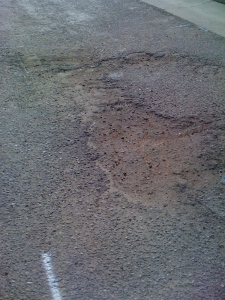Pothole Patching
Potholes ? no one likes them. They seem to pop up by magic almost overnight. Potholes are a form of disintegration of the pavement that may be associated with poorly compacted material, raveling, cracking, base failure or aging of the pavement. They often appear after rain or during thaw periods when pavements are weaker. The generally accepted mechanisms for pothole formation are as follows:
– raveling, stripping, or cracking in the pavement surface;
– moisture intrusion which weakens the underlying pavement layers;
– ice formation and heaving in the pavement;
– loss of fines from the underlying pavement layers which reduces support for the pavement surface; and
– traffic … to “grow” the pothole.
Construction procedures for pothole patching vary with method and materials selected. There are three primary patching techniques, throw and roll, semi-permanent patches and injection patching; an overview of each follows.
Throw and Roll
The “throw and roll” method is often used for temporary patches. It is only appropriate when weather conditions do not allow for a semi-permanent patch to be placed, or the road is due for rehabilitation in the very near future. It is the least expensive and least labor-intensive method for patching a pothole and includes the following steps:
– Patching material is placed into the hole, with or without cleaning and/or drying of the hole.
– The material is compacted using the maintenance truck tires.
– The finished patch should have ? to ¼ inch crown to prevent water ponding.
Semi-Permanent Patching
Semi-permanent patching is considered to be an effective patching method (second only to complete removal and replacement of the failed area). The steps of this method are summarized as follows:
– Mark the boundaries of the distressed area, taking care to encompass a slightly larger area than that reflected by the distress. The repair boundaries should be as rectangular as possible and take into consideration the dimensions of the equipment that will be used for removal of the old material and compaction of the new material.
– Cut the boundaries of the patch square using either a diamond saw or pneumatic hammer with a spade bit.
– Square up the sides of the hole until the edges of the hole are sound pavement.
– Remove water and debris from the hole and apply a tack coat of asphalt emulsion to the sides and bottom of the hole at a rate of approximately 0.2 gal/yd2.
– Place the patch material in the hole, taking care to avoid segregation. The hole should be overfilled by 20 to 25 percent of its depth to provide adequate material for compaction.
– Compact the patch material with a hand device or a small vibratory roller.
– The finished patch should have a ? to ¼ inch crown. Seal the edges with crack sealant.
Injection Patching
Injection patching is a rapid and effective method of patching that requires specialized equipment. This method, not currently used by Caltrans, is used for low volume traffic roads and is an alternative to the throw and roll method. The patches are temporary, but generally have a longer life than throw and roll patches. Details on the procedure and specialized equipment may be found in the Caltrans Maintenance Technical Advisory Guide.
To improve the durability of any patch, the edges should be sealed to prevent the intrusion of water and other debris. Sealing materials may be rubberized to allow for differential movement between the existing pavement material and the new patch material.
Next week, dig outs.
References:
1) Michigan Department of Transportation (MDOT), 2001. Birth of a Pothole, http://www.dot.state.mn.us/information/potholes/michdot/michdotpotholes.html, 2001.
2) Caltrans, Maintenance Technical Advisory Guide, Volume I, Flexible Pavement Preservation, Second Edition, 2008.
3) T Wilson and A Romine, Materials and Procedures for Repair of Potholes in Asphalt- Surface Pavements, FHWA-RD-99-168, Washington, DC, 1999.
About Century Paving
Century Paving is a general engineering contractor specializing in asphalt and concrete maintenance and repair. We offer a complete line of services to support your maintenance needs. Century Paving is based in Southern California and has a sister office in Northern California. Century Paving was established in 1974 and has successfully completed over 10,000 projects both large and small. Our staff and crews focus on quality work at a reasonable price.
For more information or to get a quote visit us: or Call us at 800-728-3488 or visit us at www.paveit.com

